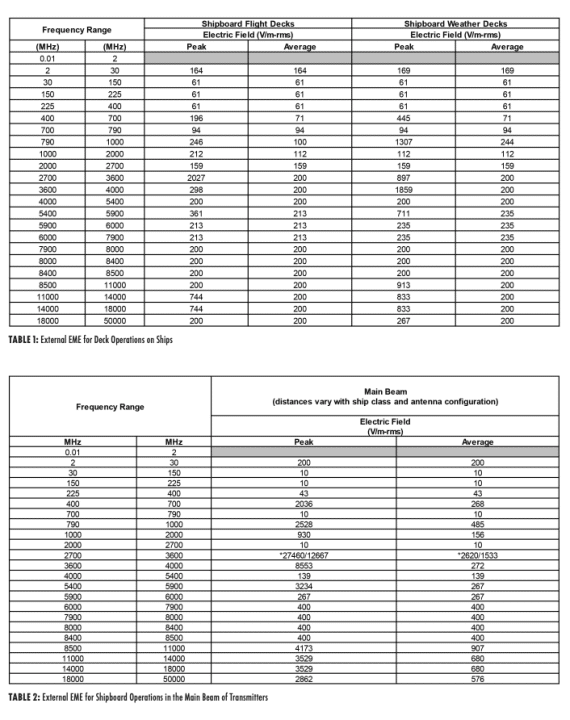Responding to increasing criticism, Secretary of Defense William Perry issued a memorandum in 1994 that effectively eliminated the use of most defense standards. This has become known as the “Perry memo”. Many defense standards were canceled. In their place, the DOD encouraged the use of industry standards for quality assurance. MIL-STD-464 was developed as an “Interface Standard” to allow usage without a waiver.The E3 (Electromagnetic Environmental Effects) area addresses a number of interfacing issues with environments both external to the system and within the system.Each system must be compatible with itself, other systems, and the external environment to ensure required performance. MIL-STD-464C is a standard to establish requirements for how systems must interface with each other in the E3 arena. It provides E3 interface requirements and verification criteria and applies to complete airborne, sea, space, and ground systems, including associated ordnance. It applies to both new and modified systems. What it does not provide is pass/fail criteria and test procedures. It should be noted that while MIL-STD-464C is a system/platform level interface standard and is not intended to be used directly for equipment and subsystems, it is the origin of E3 requirements flow down to equipment and subsystems.
This standard contains two sections, the main body and an appendix.The main body of the standard defines a baseline set of E3 requirements and provides specific guidance to different categories, e.g. intra-system EMC, shipboard internal EME, external RF EME and various other E3 disciplines. It also includes sections on notes,information on Data Item Descriptions, tailoring guidance, references to similar NATO documentation and points of contact.
The appendix provides rationale, guidance, and lessons learned for each requirement to enable the procuring activity to tailor the baseline requirements for a particular application. The appendix also permits government and industry personnel to understand the purpose of the requirements and potential verification methodology for a design. The appendix is not a mandatory part of this document but is critical to understanding the standard. It is often said that if someone wants to understand MIL-STD-464C, they should skip straight to the appendix! The following sections will review the detailed requirements cited in MIL-STD-464C.
Margins
Due to the variability in hardware and production processes for a given system, MIL-STD-464C requires that margins be provided based on system operational performance requirements, tolerances in system hardware, and uncertainties involved in verification of system-level design requirements. Specifically, safety critical and mission critical system functions require a margin of at least 6 dB. Electrically initiated Devices (EIDs)require a margin of at least 16.5 dB of the maximum no-fire stimulus (MNFS) for safety assurances and 6 dB of MNFS for other applications. Margins are typically levied on systems for specific environments external to the system. In general, these include direct effects oflightning, Electromagnetic Pulse (EMP) and Hazards of Electromagnetic Radiation to Ordnance (HERO).
A common misconception is that the application of margin requirements is an increase in the requirement level. This is not the intent of the requirement. In fact, the most common approach for verifying margins is to monitor currents and/or voltages during testing at the requirement level and demonstrate margins based on equipment strength as opposed to over testing. In the case of space based systems, determining and verifying margin requirements is critical due to the inherent inability to repair or replace components.
Intra-System EMC
As obvious as it may seem, MIL-STD-464C provides requirements for and addresses Intra-System EMC. Specifically, the requirements state, ”The system shall be electromagnetically compatible within itself such that system operationalperformance requirements are met. Compliance shall be verified by system-level test, analysis,or a combination thereof.” The majority of intra-system EMC issues involve antenna-connected transmitters and receivers such as degraded receiver performance due to electromagnetic fields radiated from onboardantennas. Ensuring intra-system EMC is typically accomplished by a combination of analysis and test.
Surface ship applications must contend with Intermodulation Interference (IMI) concerns. When two signals of different frequencies mix in a non-linear junction, a signal is created at an intermodulation frequency. When an antenna-connected receiver is MILITARY EMC Interference Technology Mini Guide tuned to the intermodulation frequency, interference may occur. The intra-system EMC requirement is considered to be met forhull generated IMI when IMI product orders higher than 19th order produced by High Frequency(HF) transmitters installed onboard ship are not detectable by antenna-connected receiversonboard ship.
In addition to controlling hull generated IMI, limits are placed on the maximum EME allowed in internal spaces on board surface ships and submarines. The requirements for surface ships are specified for both metallic and non-metallic hulls. Metallic hulls are limited to 10 V/m from 10 kHz to 18 GHz and non-metallic hulls are limited to 10 V/m from 10 kHz to 2 MHz, 50 V/m from 2 MHz to 1 GHz and 10 V/m from 1 GHz to 18 GHz. The increased use of wireless systems below decks, is considered as well with limitations placed on the effective isotropic radiated power (EIRP) and the total radiated power (TRP). For metallic hulls, the EIRP is limited to a maximum of 100 mW and the total combined powerradiated within a compartment and within the operating frequency band is limited to 550 mW TRP. For non-metallic hulls, the EIRP is limited to a maximum of 100 mW and the total combined powerradiated within a compartment and within the operating frequency band is limited to 13.75 W TRP. For submarines, the limits are 5 V/m from 10 kHz to 30 MHz and10 V/m from 30 MHz to 18 GHz with and the EIRP is limited to a maximum of 25 mW and the total combined powerradiated within a compartment and within the operating frequency band is limited to 50 mWTRP. In all cases, no transmitting devices are allowed to be permanently installed within 1 meter of safety or mission critical equipment.
Multipaction occurs when RF fields accelerate electrons in a vacuum and cause them to impact with a surface, which may release additional electrons into the vacuum. These electrons can then be accelerated by the RF fields and impact with the same or another surface. If the frequency of the signal is such that the RF field changes polarity in concert with the production of the secondary electrons, the secondary electrons are then accelerated resulting in more electrons leading to potential interference or damage. MIL-STD-464C requires that equipment and subsystems used in space applications be free of mulitpaction effects.
Unintentional radiated emissions coupled to antennas can be above the noise floor of receivers resulting in performance degradation and hence the signals present at antenna ports of antenna-connected receivers must be controlled. The most common unintentional emissions are caused by microprocessor clock harmonics and cable radiation, however, other sources may also be present.
External EME
Perhaps the most commonly invoked requirement from MIL-STD-464C is the external EME. This area also tends to be the most complicated requirement to verify for a number of reasons. MIL-STD-464C presents several tables defining the EME for particular installations and applications.
In all, there are six tables provided:
Table 1 – External EME for deck operations on ships
Table 2 – External EME for shipboard operations in the main beam of transmitters
Table 3 – External EME for space and launch vehicle systems
Table 4 – External EME for ground systems
Table 5 – External EME for Army rotary wing aircraft
Table 6 – External EME for fixed wing aircraft, excluding shipboard operations
In addition, the appendix provides an EME table for specialized Army rotorcraft testing.
The tables provide peak and average E-Field levels over frequency and were developed based on MILHDBK-235. The external EMEs are shown in Tables 1 through 6.






